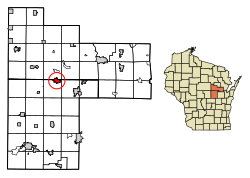Marion, Wisconsin | |
|---|---|
 Location of Marion in Waupaca (below) and Shawano (above) counties, Wisconsin | |
| Coordinates: 44°40′21″N88°53′11″W / 44.67250°N 88.88639°W | |
| Country | |
| State | |
| Counties | Waupaca, Shawano |
| Incorporated (village) | December 12, 1898 |
| Incorporated (city) | July 29, 1939 [1] |
| Government | |
| • Mayor | Christopher Goke |
| Area | |
• Total | 2.59 sq mi (6.71 km2) |
| • Land | 2.45 sq mi (6.35 km2) |
| • Water | 0.14 sq mi (0.36 km2) |
| Elevation | 850 ft (259 m) |
| Population | |
• Total | 1,324 |
| • Density | 510/sq mi (200/km2) |
| Time zone | UTC-6 (Central (CST)) |
| • Summer (DST) | UTC-5 (CDT) |
| Area codes | 715 & 534 |
| FIPS code | 55-49400 [5] |
| GNIS feature ID | 1569041 [3] |
| Website | cityofmarionwi |
Marion is a city in Shawano and Waupaca counties in the U.S. state of Wisconsin. The population was 1,324 at the 2020 census.



